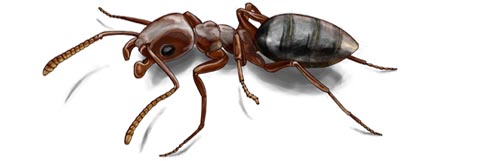Odorous House Ant

Odorous House Ant
Odorous House Ant/Order/Family: Hymenoptera/Formicidae/Scientific Name: Tapinoma sessile (Say).
Description:
Odorous ant workers are brown to black and 1/16- to 1/8-inch long. The thorax has no spines, and the petiole has one segment which, when viewed from above, is hidden by the rest of the abdomen. There is a slit at the tip of the abdomen instead of a circlet of hairs. The best identifying characteristic is the “rancid butter” smell these ants produce when they are crushed; hence their name. When alarmed, the workers scurry around with their abdomens raised in the air.
Biology:
These ants swarm to mate from early May through mid-July, and also mate in the nest, forming new colonies by “budding” off the original colony. A colony has approximately 10,000 workers and several queens, each laying one egg a day. Developmental time (egg to adult) is 34-83 days; however, during the winter, it may take six to seven months. There are several generations per year. Workers and queens live for several years.
Habits:
Odorous house ants often nest outdoors under stones, logs, and in the nests of larger ants. They can also nest indoors in wall or floor voids, around heat sources, (e.g., hot water pipes and heaters, crevices around sinks and cabinets). Odorous house ants travel in trails and prefer sweets although they eat almost any household food. They usually invade structures during rainy periods after honeydew on plants has washed off.
Control:
Odorous house ants are very difficult to control. All cracks and gaps in exterior walls that proide access to voids or interior areas should be sealed. All debris from the exterior of the structure and other items on the ground where these ants nest should be removed.
Odorous house ants prefer sweets but are not easily controlled using sweetened baits. Baits should be placed where ant trails have been established or in locations where the ants have been sited. Unless using containerized baits indoors, baits should be placed so they are inaccessible to children and pets. Sweet baits are the most effective, but if acceptance is low, a protein bait should be considered. In areas where workers are observed the ready-to-use ant baits (syrups or solid pellets in a small canister) can be placed on or along trails, being careful to exclude contact with the bait by children and pets.
The most effective control is accomplished by following ant trails, locating the nest, and treating them with a residual insecticide. Exterior nests should be drenched with a liquid formulation. Nests in wall voids are more easily treated by aerosol injection or application of a dust formulation. When the nests can not be located, a barrier spray should be applied to foundations and the soil immediately adjacent to the building. This is effective in repelling foraging workers and preventing them from reentering the structure.
Click On The Pest Category To Learn More.
| Bedbug Guide | House Centipedes |
| Carpenter Ants | Mosquitoes |
| Clothes Moths | Roaches |
| Fly Facts | Ants vs Termites |
| Little Black Ant | Termites |
| Odorous House Ant | House Flies |
| Fruit Flies | Rodents |






